

Compact Muon Solenoid
LHC, CERN
| CMS-PAS-SMP-18-007 | ||
| Measurement of electroweak production of Z$\gamma$ in association with two jets in proton-proton collisions at $\sqrt{s}$ = 13 TeV | ||
| CMS Collaboration | ||
| July 2019 | ||
| Abstract: A measurement of electroweak production of a Z boson and a photon in association with two jets in proton-proton collisions is presented. The Z boson candidates are selected through their decay into a pair of electrons or muons. The electroweak production of the Z$\gamma$jj final state is isolated by selecting events with a large dijet mass and a large rapidity gap between the two jets. The measurement is based on data collected with the CMS detector in 2016 at a center-of-mass energy of 13 TeV corresponding to an integrated luminosity of 35.9 fb$^{-1}$. The observed significance of the signal is 3.9 standard deviations, where a significance of 5.2 standard deviations is expected based on the standard model. The results are combined with previously published CMS results based on $\sqrt{s}=$ 8 TeV data, which leads to an observed (expected) significance of 4.7 (5.5) standard deviations. A cross section measurement in a fiducial region is reported. Bounds are given on quartic vector boson interactions in the framework of dimension-8 effective field theory operators. | ||
|
Links:
CDS record (PDF) ;
CADI line (restricted) ;
These preliminary results are superseded in this paper, JHEP 06 (2020) 076. The superseded preliminary plots can be found here. |
||
| Figures | |
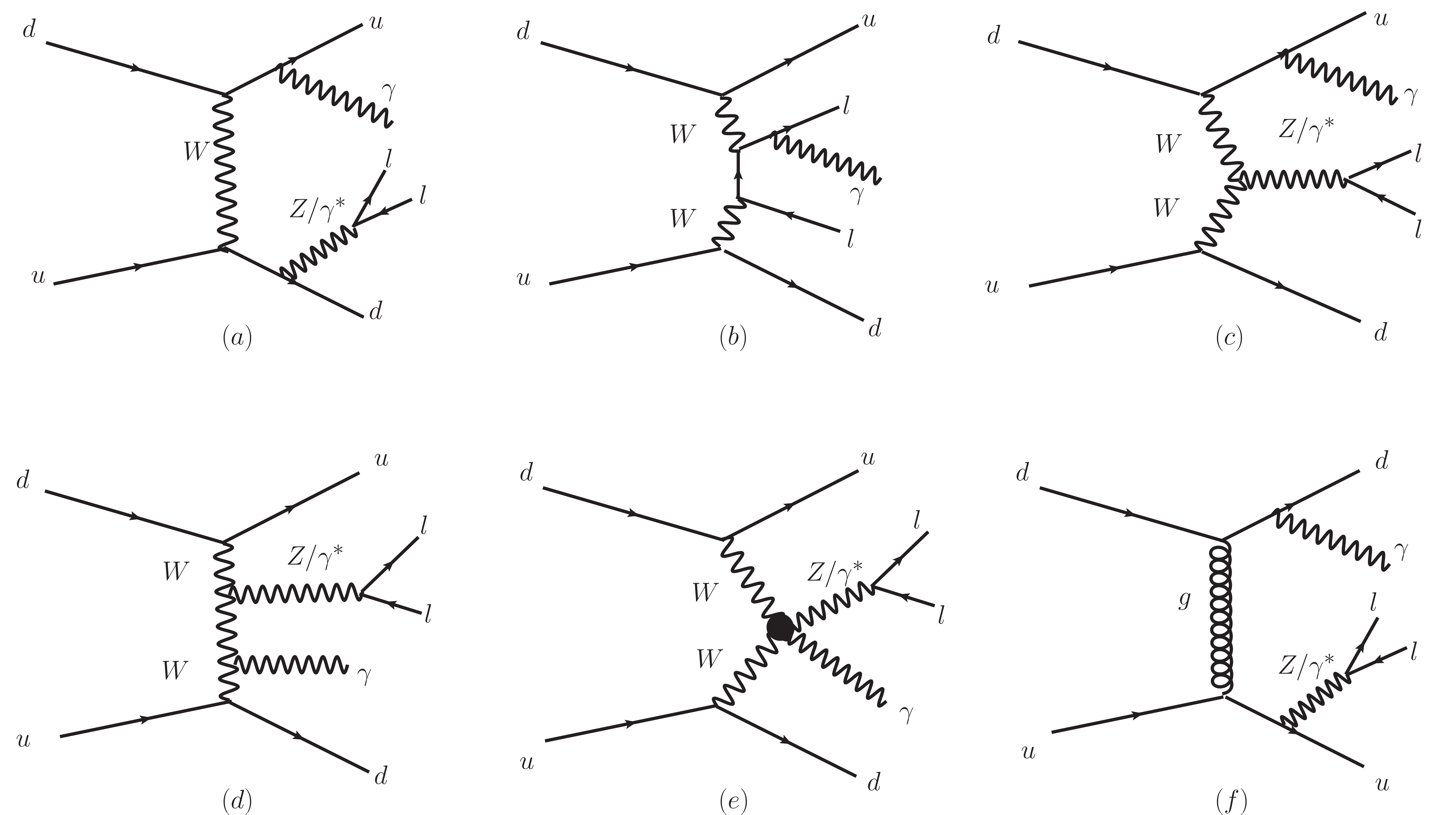
png pdf |
Figure 1:
Representative diagrams for EW and QCD Z$\gamma $jj production at the LHC. (a)-(e) are EW diagrams: (a) bremsstrahlung, (b) multiperipheral, (c,d) VBF with TGC, and (e) VBS including QGC. (f) is a QCD diagram. |

png pdf |
Figure 2:
The $m_{\text {jj}}$ distributions measured in the (left) dimuon plus barrel photon and (right) dielectron plus barrel photon categories. The data (solid symbols with error bars representing the statistical uncertainties) are compared to a data-driven background estimation, combined with MC predictions. The hatched bands represent the statistical uncertainty of the combined prediction of the signal and all of the backgrounds. The last bin includes overflow events. |

png pdf |
Figure 2-a:
The $m_{\text {jj}}$ distributions measured in the dimuon plus barrel photon category. The data (solid symbols with error bars representing the statistical uncertainties) are compared to a data-driven background estimation, combined with MC predictions. The hatched bands represent the statistical uncertainty of the combined prediction of the signal and all of the backgrounds. The last bin includes overflow events. |
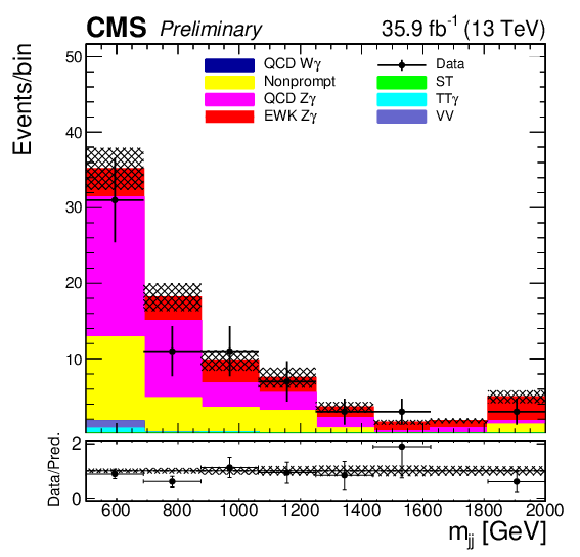
png pdf |
Figure 2-b:
The $m_{\text {jj}}$ distributions measured in the dielectron plus barrel photon category. The data (solid symbols with error bars representing the statistical uncertainties) are compared to a data-driven background estimation, combined with MC predictions. The hatched bands represent the statistical uncertainty of the combined prediction of the signal and all of the backgrounds. The last bin includes overflow events. |
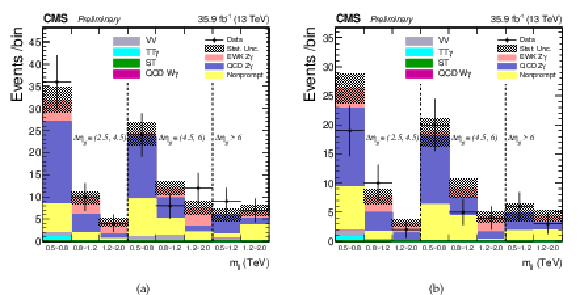
png pdf |
Figure 3:
The post-fit 2D distribution region in the dimuon plus barrel photon category (left) and the dielectron plus barrel photon category (right). The data (solid symbols with error bars representing the statistical uncertainties) are compared to the prediction in the signal region. The hashed bands represent the full uncertainties. |
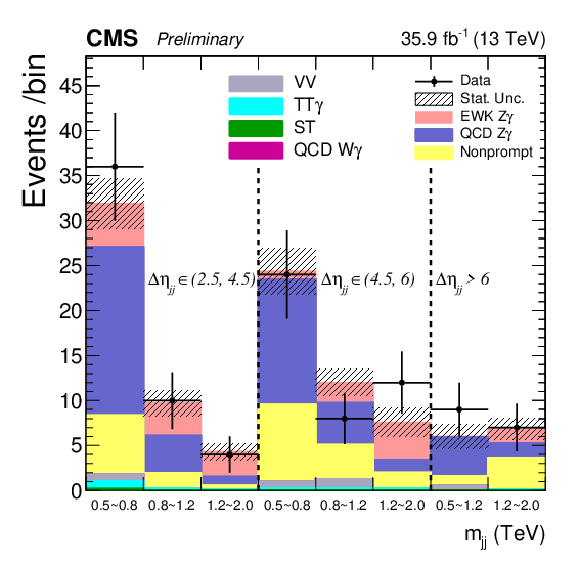
png pdf |
Figure 3-a:
The post-fit 2D distribution region in the dimuon plus barrel photon category. The data (solid symbols with error bars representing the statistical uncertainties) are compared to the prediction in the signal region. The hashed bands represent the full uncertainties. |

png pdf |
Figure 3-b:
The post-fit 2D distribution region in the dielectron plus barrel photon category. The data (solid symbols with error bars representing the statistical uncertainties) are compared to the prediction in the signal region. The hashed bands represent the full uncertainties. |
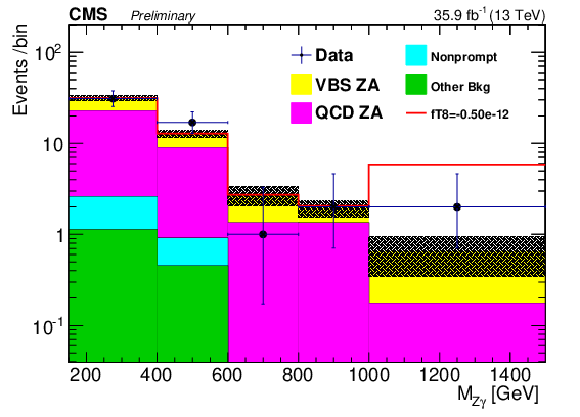
png pdf |
Figure 4:
The $m_{Z\gamma}$ distribution of events satisfying the aQGC region selection, which is used to set constraints on the anomalous coupling parameters. The red line represents a nonzero $F_{\text {T,8}}$ setting, which would significantly enhance the yields at high $m_{Z\gamma}$. The last bin includes overflow. The hatched bands represent the total uncertainties of the predictions. |
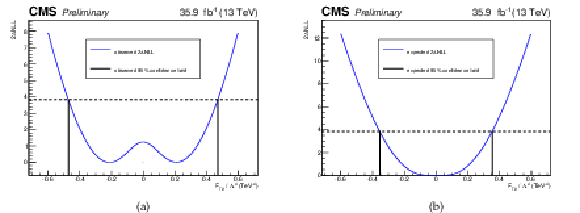
png pdf |
Figure 5:
Observed (left) and expected (right) 95% CL intervals on aQGC parameter $F_{\text {T,8}}$. |

png pdf |
Figure 5-a:
Observed 95% CL interval on aQGC parameter $F_{\text {T,8}}$. |
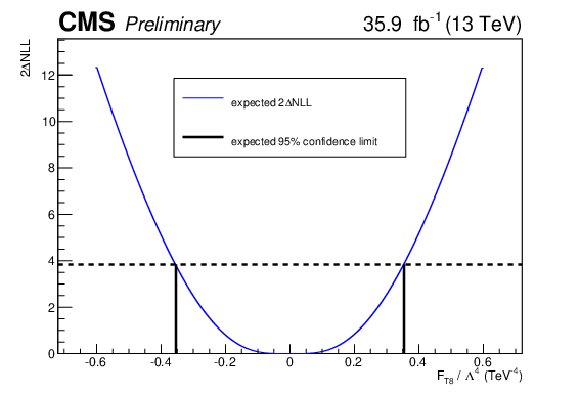
png pdf |
Figure 5-b:
Expected 95% CL interval on aQGC parameter $F_{\text {T,8}}$. |
| Tables | |

png pdf |
Table 1:
Summary of four different event selection criteria: (1) Common event selection; (2) Selection for the control region; (3) selection for the EW signal extraction; (4) selection for the fiducial cross section measurement; (5) selection for the aQGC search. "j1" and "j2" represent the jets that have the largest and second-largest $p_T$, "l1" and "l2" denote the selected leptons, and the angular separation $\Delta R = \sqrt {(\Delta \eta)^2 + (\Delta \phi)^2}$. |
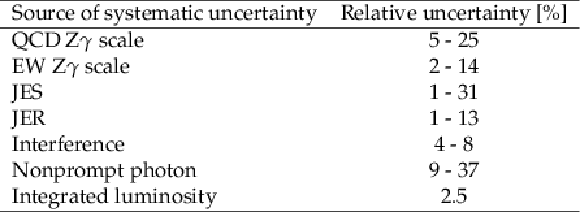
png pdf |
Table 2:
The dominant systematic uncertainties in the signal extraction measurement. |
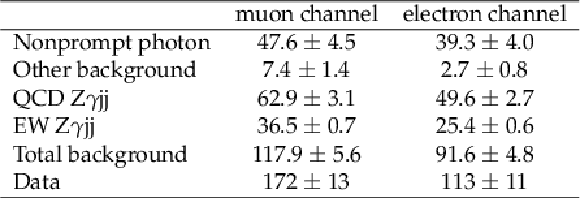
png pdf |
Table 3:
Expected signal and background yields and observed data event counts after the final selection for the EW signal search. The statistical and systematic uncertainties are added in quadrature. |
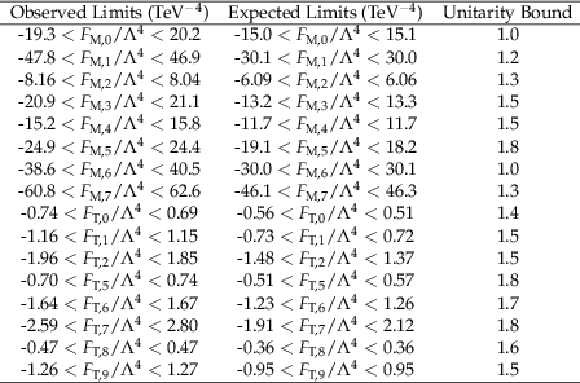
png pdf |
Table 4:
95% C.L. Z$\gamma $ shape-based exclusion limits listed for each aQGC parameter. The unitarity bounds are also listed. All coupling parameter limits are in units of TeV$^{-4}$, while the unitarity bounds are in units of TeV. No form factor is applied. |
| Summary |
| In this paper, we have presented a measurement of vector boson scattering in the Z$\gamma$ final state. The data sample corresponds to an integrated luminosity of 35.9 fb$^{-1}$ collected at $\sqrt{s}=$ 13 TeV with the CMS detector. Events are selected by requiring exactly two identified leptons along with two jets that have a large rapidity separation and a large dijet mass. The observed signal significance for the 2016 dataset is 3.9 standard deviations, where a significance of 5.2 standard deviations is expected based on the standard model. When this new result is combined with 8 TeV CMS results, the observed (expected) significance is 4.7 (5.5). The best-fit electroweak (EW) Z$\gamma$jj signal strength in the fiducial region is $\mu_{\text{EW}} = $ 0.64$^{+0.23}_{-0.21}$, corresponding to a fiducial cross section of 3.20 $\pm$ 1.15 fb. The best-fit signal strength of EW + quantum chromodynamics (QCD) Z$\gamma$jj in the fiducial region is $\mu_{\text{EW+QCD}} = $ 0.96$^{+0.15}_{-0.13}$, corresponding to a fiducial cross section 15.07 $\pm$ 2.40 fb. Constraints are placed on anomalous quartic gauge couplings in terms of dimension-eight effective field theory operators and the results are competitive or more stringent than previous constraints. |
| References | ||||
| 1 | ATLAS Collaboration | Observation of a new particle in the search for the standard model Higgs boson with the ATLAS detector at the LHC | PLB 716 (2012) 1 | 1207.7214 |
| 2 | CMS Collaboration | Observation of a new boson at a mass of 125 GeV with the CMS experiment at the LHC | PLB 716 (2012) 30 | CMS-HIG-12-028 1207.7235 |
| 3 | S. Malhotra | Measuring the Properties of the Higgs Boson at CMS | Nuclear and Particle Physics Proceedings, 37th International Conference on High Energy Physics (ICHEP 2016) | |
| 4 | CMS Collaboration | Observation of electroweak production of same-sign W boson pairs in the two jet and two same-sign lepton final state in proton-proton collisions at $ \sqrt{s} = $ 13 TeV | PRL 120 (2018) 081801 | CMS-SMP-17-004 1709.05822 |
| 5 | ATLAS Collaboration | Studies of Z$ \gamma $ production in association with a high-mass dijet system in pp collisions at $ \sqrt{s}= $ 8 TeV with the ATLAS detector | JHEP 07 (2017) 107 | 1705.01966 |
| 6 | CMS Collaboration | Measurement of the cross section for electroweak production of Z$ \gamma $ in association with two jets and constraints on anomalous quartic gauge couplings in proton--proton collisions at $ \sqrt{s} = $ 8 TeV | PLB 770 (2017) 380 | CMS-SMP-14-018 1702.03025 |
| 7 | CMS Collaboration | The CMS experiment at the CERN LHC | JINST 3 (2008) S08004 | CMS-00-001 |
| 8 | CMS Collaboration | The CMS trigger system | JINST 12 (2017) P01020 | CMS-TRG-12-001 1609.02366 |
| 9 | J. Alwall et al. | The automated computation of tree-level and next-to-leading order differential cross sections, and their matching to parton shower simulations | JHEP 07 (2014) 079 | 1405.0301 |
| 10 | R. Frederix and S. Frixione | Merging meets matching in MC@NLO | JHEP 12 (2012) 061 | 1209.6215 |
| 11 | T. Sjostrand et al. | An Introduction to PYTHIA 8.2 | CPC 191 (2015) 159 | hep-ph/1410.3012 |
| 12 | S. Alioli, P. Nason, C. Oleari, and E. Re | A General Framework for Implementing NLO Calculations in Shower Monte Carlo Programs: the POWHEG BOX | JHEP 07 (2010) | 1002.2581 |
| 13 | P. Skands, S. Carrazza, and J. Rojo | Tuning PYTHIA 8.1: the Monash 2013 tune | EPJC 74 (2014) 3024 | 1404.5630 |
| 14 | CMS Collaboration | Event generator tunes obtained from underlying event and multiparton scattering measurements | EPJC 76 (2016) 155 | CMS-GEN-14-001 1512.00815 |
| 15 | M. Cacciari, G. P. Salam, and G. Soyez | FastJet user manual | EPJC 72 (2012) 1896 | 1111.6097 |
| 16 | GEANT4 Collaboration | GEANT4 --- a simulation toolkit | NIMA 506 (2003) 250 | |
| 17 | CMS Collaboration | Measurement of the Inclusive W and Z Production Cross Sections in pp Collisions at $ \sqrt{s} = $ 13 TeV | JHEP 10 (2011) 132 | CMS-EWK-10-005 1107.4789 |
| 18 | CMS Collaboration | Particle-flow reconstruction and global event description with the CMS detector | JINST 12 (2017) P10003 | CMS-PRF-14-001 1706.04965 |
| 19 | M. Cacciari, G. P. Salam, and G. Soyez | The anti-$ {k_{\mathrm{T}}} $ jet clustering algorithm | JHEP 04 (2008) 063 | 0802.1189 |
| 20 | M. Cacciari, G. P. Salam, and G. Soyez | FastJet user manual | EPJC 72 (2012) 1896 | 1111.6097 |
| 21 | CMS Collaboration | Performance of electron reconstruction and selection with the CMS detector in proton-proton collisions at $ \sqrt{s} = $ 8 TeV | JINST 10 (2015) P06005 | CMS-EGM-13-001 1502.02701 |
| 22 | CMS Collaboration | Energy calibration and resolution of the CMS electromagnetic calorimeter in pp collision at $ \sqrt{s}= $ 7 TeV | JINST 8 (2013) P09009 | CMS-EGM-11-001 1306.2016 |
| 23 | CMS Collaboration | Performance of electron reconstruction and selection with the CMS detector in proton-proton collisions at $ \sqrt{s}= $ 8 TeV | JINST 10 (2015) P06005 | CMS-EGM-13-001 1502.02701 |
| 24 | CMS Collaboration | Performance of the CMS muon detector and muon reconstruction with proton-proton collisions at $ \sqrt{s}= $ 13 TeV | JINST 13 (2018) P06015 | CMS-MUO-16-001 1804.04528 |
| 25 | CMS Collaboration | Determination of jet energy calibration and transverse momentum resolution in CMS | JINST 6 (2011) P11002 | CMS-JME-10-011 1107.4277 |
| 26 | CMS Collaboration | Measurement of W$ \gamma $ and Z$ \gamma $ production in pp collisions at $ \sqrt{s} = $ 7 TeV | PLB 701 (2011) 535 | CMS-EWK-10-008 1105.2758 |
| 27 | CMS Collaboration | CMS luminosity measurements for the 2016 data taking period | CMS-PAS-LUM-17-001 | CMS-PAS-LUM-17-001 |
| 28 | J. Butterworth et al. | PDF4LHC recommendations for LHC Run II | JPG 43 (2016) 023001 | 1510.03865 |
| 29 | T. Junk | Confidence level computation for combining searches with small statistics | NIMA 434 (1999) 435 | hep-ex/9902006 |
| 30 | A. L. Read | Presentation of search results: the $ CL_s $ technique | JPG 28 (2002) 2693 | |
| 31 | G. Cowan, K. Cranmer, E. Gross, and O. Vitells | Asymptotic formulae for likelihood-based tests of new physics | EPJC 71 (2011) 1554 | 1007.1727 |
| 32 | O. J. P. Éboli, M. C. Gonzalez-Garcia, and J. K. Mizukoshi | pp$ \rightarrow $ jje$ ^\pm \mu^\pm \nu\nu $ and jje$ ^\pm\mu^\mp\nu\nu $ at $ \cal $ o($ \alpha^6_{\rm em} $) and $ \cal $ o($ \alpha_{em}^4 \alpha_s^2 $) for the study of the quartic electroweak gauge boson vertex at CERN LHC | PRD 74 (2006) 073005 | hep-ph/0606118 |
| 33 | S. S. Wilks | The Large-Sample Distribution of the Likelihood Ratio for Testing Composite Hypotheses | Ann. Math. Statist 9 (1938) 60 | |
| 34 | CMS Collaboration | Precise determination of the mass of the Higgs boson and tests of compatibility of its couplings with the standard model predictions using proton collisions at 7 and 8 TeV | EPJC 75 (2015) 212 | CMS-HIG-14-009 1412.8662 |
| 35 | K. Arnold et al. | VBFNLO: A parton level Monte Carlo for processes with electroweak bosons | CPC 180 (2009) 1661 | 0811.4559 |

|
Compact Muon Solenoid LHC, CERN |

|

|

|

|

|

|